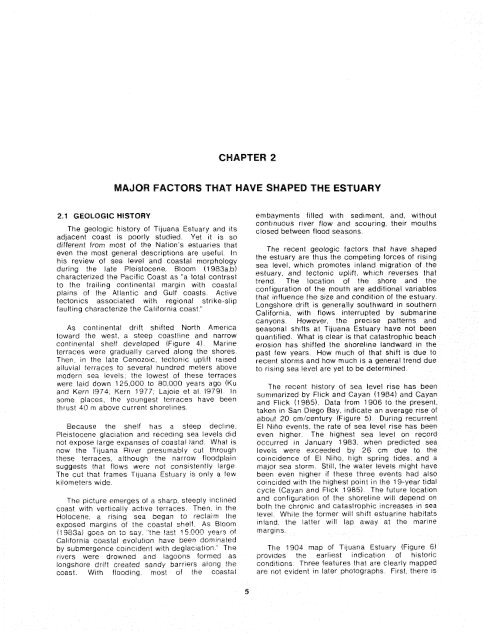The Ecology of Tijuana Estuary, California: An Estuarine Profile
The Ecology of Tijuana Estuary, California: An Estuarine Profile
The Ecology of Tijuana Estuary, California: An Estuarine Profile
Create successful ePaper yourself
Turn your PDF publications into a flip-book with our unique Google optimized e-Paper software.
CHAPTER 2<br />
MAJOR FACTORS THAT HAVE SHAPED THE ESTUARY<br />
2.1 GEOLOGIC HISTORY embayments filled with sediment, and, without<br />
continilous river flow and scouring, their mouths<br />
<strong>The</strong> geologic history <strong>of</strong> <strong>Tijuana</strong> <strong>Estuary</strong> and its closed between flood seasons,<br />
adiacent coast is poorly studied. Yet it is so<br />
different from most <strong>of</strong> the Nation's estuaries that<br />
<strong>The</strong> recent geologic factors that have shaped<br />
even the most general descriptions are useful. In<br />
the estuary are thus the competing forces <strong>of</strong> rising<br />
his review <strong>of</strong> sea level and coastal morphology<br />
sea level, which promotes Inland migration <strong>of</strong> the<br />
during the late Pleistocene, Bloom (1983a,b)<br />
estuary, and tectonic upl~ft, whrch reverses that<br />
characterized the Pacific Coast as "a total contrast<br />
trend <strong>The</strong> location <strong>of</strong> the shore and the<br />
to the trailing corltinental margin with coastal<br />
conftguratlon ot the mouth are addrt~onal variables<br />
plains <strong>of</strong> the Atlantic and Gulf coasts. Active<br />
that influence the srze and cond~tion <strong>of</strong> the estuary<br />
tectonics associated with regional strike-slip<br />
Longshore drift is generally southward In southern<br />
faulting characterize the <strong>California</strong> coast."<br />
<strong>California</strong>, w~th flows interrupted by submarine<br />
canyons However, the precise patterns and<br />
As continental drift shifted North America seasonal sh~fts at <strong>Tijuana</strong> <strong>Estuary</strong> have not been<br />
toward the west, a steep coastline and narrow quaritified What is clear IS that catastrophic beach<br />
contrnental shelf developed (Figure 4) Marine<br />
terraces were gradually carved along the shores<br />
<strong>The</strong>n In the late Cenozo~c, tectonic upl~ft raised<br />
ailuvlal terraces to several hundred meters above<br />
modern sea levels, the lowest <strong>of</strong> these terraces<br />
were Iatd down 125,000 to 80,000 years ago (Ku<br />
and Kern 1974, Kern 1977. Lajoie et al 1979) In<br />
some places, the youngest terraces have been<br />
thrust 40 m above current shorelines<br />
Because the shelf has a steep decline,<br />
Pleistocene glaciation and receding sea levels did<br />
not expose large expanses <strong>of</strong> coastal land What IS<br />
now the Tljuana Rlver presumably cut through<br />
these terraces, although the narrow fioodplaln<br />
suggests that flows were not consrstently large<br />
<strong>The</strong> cut that frames <strong>Tijuana</strong> <strong>Estuary</strong> IS only a few<br />
kilometers wide<br />
<strong>The</strong> plcture emerges <strong>of</strong> a sharp. steeply inclined<br />
coast with vertically acttve terraces <strong>The</strong>n, In the<br />
Holocene, a rising sea began to reclarm the<br />
exposed margins <strong>of</strong> the coastal shelf As Bloorn<br />
(I%$%) gftes on :o say. "the !ast 15.05?0 years <strong>of</strong><br />
Californ~a coastal evolution have been dtjmrnated<br />
by submergence coincident with deglaciation' <strong>The</strong><br />
rivers were drowned and lagoons formed as<br />
longshore drift created sandy barrrers along the<br />
coast W~th flooding most <strong>of</strong> the coastal<br />
eroslon has shifted the sllorel~ne landward in the<br />
past few years How much <strong>of</strong> that shift is due to<br />
recent storms and how much IS a general trend due<br />
to rrsir-ig sea level are yet to be determined<br />
<strong>The</strong> recent htstory <strong>of</strong> sea level rlse has been<br />
sumrnarized by Flick and Cayan (1984) and Cayan<br />
and Flick (1985) Data from 1906 to the present.<br />
taken in San Dfego Bay, indicate an average rise <strong>of</strong><br />
about 20 cm/century (Figure 5) Dur~ng recurrent<br />
El Nino events, the rate <strong>of</strong> sea level rise has been<br />
even higher <strong>The</strong> hlghest sea level on record<br />
occurred in January 1983, when predicted sea<br />
levels were exceeded by 26 cm due to the<br />
coincidence <strong>of</strong> El Nino, high spring tides, and a<br />
major sea storm Still, the water levels might have<br />
been even higher if these three events had also<br />
coincided with the hlghest pornt In the 19-year tidal<br />
cycle (Cayan and Ftick 1985) <strong>The</strong> future locatlon<br />
and configuration <strong>of</strong> the shorelrne will depend on<br />
both the chron~c and catastrophic increases In sea<br />
level While the former will shlft estuarine habitats<br />
~nland the latter will lap away at the marlne<br />
margins<br />
<strong>The</strong> 1904 map <strong>of</strong> <strong>Tijuana</strong> <strong>Estuary</strong> (Figure 6)<br />
prov~des the earliest indication <strong>of</strong> hiStOrlC<br />
cond~tions Three features that are clearly mapped<br />
are not evident in later photographs F~rst, there IS

















